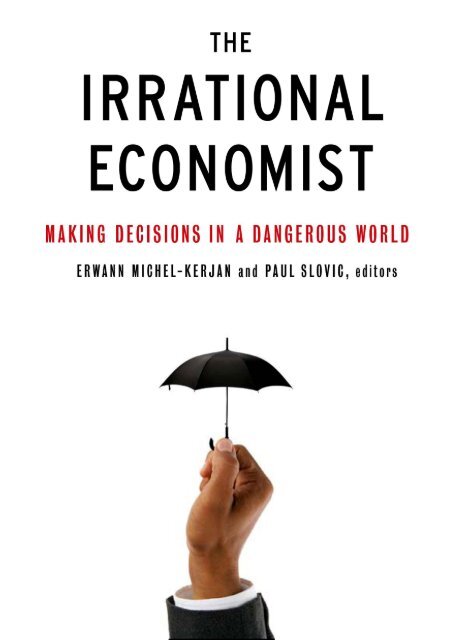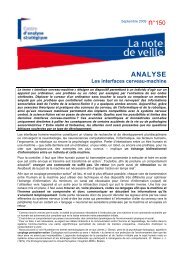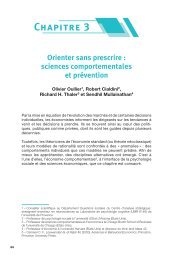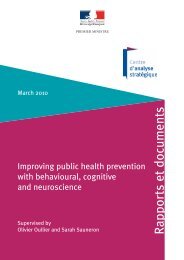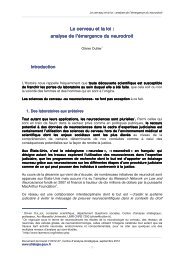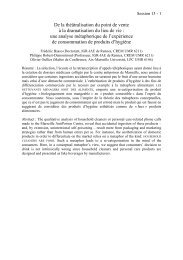The useful brain - Olivier Oullier - Free
The useful brain - Olivier Oullier - Free
The useful brain - Olivier Oullier - Free
Create successful ePaper yourself
Turn your PDF publications into a flip-book with our unique Google optimized e-Paper software.
Chapter 10<br />
<strong>The</strong> Useful Brain:<br />
How Neuroeconomics Might Change Our Views on<br />
Rationality and a Couple of Other Things<br />
<strong>Olivier</strong> <strong>Oullier</strong><br />
Humans love boxes.<br />
By boxes, I mean anything from a folder to a mental<br />
category that is supposed to facilitate our lives.<br />
Think about the hard drive of your computer. Don’t you<br />
have a bunch of folders for personal items‐‐‐where you store<br />
digital photos of people you love and work‐related documents<br />
Or a “to‐do list” with an “urgent things to be taken care of”<br />
column and a “not so urgent” one next to it<br />
In addition to the physical (and electronic) ones, there<br />
are all these mental boxes we rely on. 1 We use them to<br />
categorize and classify our thoughts (important, or not),<br />
1 Note that by distinguishing between physical and mental boxes I’m<br />
providing you with a clear illustration of my own strong tendency to make<br />
boxes!<br />
88
emotions (happiness, sadness), opinions (interesting, boring),<br />
and even people we know (relative, friends, colleagues).<br />
Whether we admit it or not, we are box‐dependent.<br />
But there is a downside to this habit. Whenever<br />
categorization enters the game, the ghost of simplification<br />
rears its head and dichotomies that are not supposed to exist<br />
are artificially created. And science has always constituted a<br />
fertile ground for artificial dichotomies to emerge and persist,<br />
sometimes forever.<br />
Think about the rationality versus emotion debate that<br />
motivates this book (two quite time‐resistant boxes, as<br />
discussed in the Introduction). As stimulating and interesting<br />
as this debate can be, we have been walking in circles for ages<br />
and some fresh insights could definitely come handy.<br />
But what if there were no such things as emotion on the<br />
one hand and rationality on the other<br />
Shaking the (Ir)Rationality Tree: Welcome to “Emo<br />
Rationality”<br />
Given our current state of knowledge in the behavioral<br />
and <strong>brain</strong> sciences, I tend to favor the following proposition,<br />
not as an economist but as a neuroscientist:<br />
<strong>The</strong> dichotomy between rational and affective decision<br />
making may be an artificial construction of our minds to help<br />
us categorize our choice behavior. From what we know so far,<br />
our <strong>brain</strong> does not seem to generate emotions and rationality<br />
in an independent fashion. Rather, it might be dealing with a<br />
complementary pair, a kind of “emo‐rationality.”<br />
89
This perspective, which has recently gained acceptance<br />
in the <strong>brain</strong> sciences, 2 still remains bizarre for (too) many<br />
economists. If confirmed, however, it could have a major<br />
impact on economics, markets, and public policy. This is why,<br />
over the past decade, I‐‐‐and a number of colleagues 3 ‐‐‐have<br />
become increasingly interested in the following question: How<br />
can the joint study of behavior and <strong>brain</strong> dynamics help<br />
economics and other social sciences take a more realistic<br />
approach to the understanding decision making processes<br />
<strong>The</strong> Curious Case of Phineas Gage<br />
<strong>The</strong> emo‐rationality idea‐‐‐although to my knowledge<br />
never before formulated this way‐‐‐has a history.<br />
It might have started in the middle of the nineteenth<br />
century, when Phineas Gage, a railroad construction worker,<br />
suffered a terrible accident that would change forever not only<br />
his life but also our understanding of the way emotions affect<br />
social behavior.<br />
On September 13, 1848, somewhere near Cavendish,<br />
Vermont, Gage was the leader of a team of men who were<br />
blasting rocks with powder in preparation for the Rutland and<br />
Burlington Railroad. Suddenly, an uncontrolled explosion sent<br />
a three‐foot, seven‐inch, thirteen‐and‐a half pound, quarterinch‐diameter<br />
iron rod through his fore<strong>brain</strong>. Literally. <strong>The</strong> rod<br />
not only penetrated the skull under the left cheekbone but<br />
went all the way up through his <strong>brain</strong> before landing some<br />
thirty yards away.<br />
2 J.A.S. Kelso and D.A. Engstrøm, <strong>The</strong> Complementary Nature (Cambridge,<br />
MA: MIT Press, 2006); L. Pessoa, “On the Relationship Between Emotion<br />
and Cognition,” Nature Reviews Neuroscience 9 (2008): 148‐‐158.<br />
3 See, for example, Colin Camerer’s chapter in this book.<br />
90
Phineas Gage survived despite the fact that a large<br />
portion of his fore<strong>brain</strong> was missing (or at least severely<br />
damaged)‐‐‐an injury that would have disrupted the dense<br />
reciprocal information exchange between the frontal lobe and<br />
deeper areas of his <strong>brain</strong>. Dr. John Martyn Harlow, a local<br />
physician thanks to whom we know so much about the case<br />
since he wrote daily reports on Gage’s condition, 4 took good<br />
care of him.<br />
Despite the hole in his skull, the survivor returned home<br />
ten weeks after the accident. He even tried to resume work less<br />
than a year later. But as his co‐workers mentioned, something<br />
had changed: “Gage was no longer Gage!”<br />
Before the accident, he was a respectful and polite<br />
person, in addition to being a dedicated and efficient employee<br />
mostly held in high esteem. Afterward, his behavior changed<br />
dramatically. He became prone to intemperate outbursts,<br />
spiteful to others, and impatient. His inability to hold to a plan<br />
for future actions and his overall lack of “emotional control”<br />
ended up costing him his job.<br />
Gage’s case, later popularized by neurologist Antonio<br />
Damasio in his best‐selling book Descartes’ Error, 5 is one of the<br />
first‐known demonstrations that the frontal areas of the <strong>brain</strong><br />
play a key role in rational behavior by “controlling” emotional<br />
reactions. 6 But one can wonder if, reciprocally, emotions<br />
participate in rational behavior.<br />
4 M. MacMillan, An Odd Kind of Fame: Stories of Phineas Gage (Cambridge,<br />
MA: MIT Press, 2000).<br />
5 A. Damasio, Descartes’ Error: Emotion, Reason, and the Human Brain (New<br />
York: Putnam Publishing, 1994).<br />
6 This approach is still used in courts to (attempt to) prove someone’s penal<br />
(ir)responsibility to the actions he or she committed. See J. Rosen, “<strong>The</strong><br />
Brain on the Stand,” New York Times, March 11, 2007.<br />
91
This is where neuroeconomics 7 comes into play.<br />
What Can We Learn from the Marriage of Economics and<br />
Neuroscience<br />
Today, this multidisciplinary field‐‐‐which brings<br />
together economics, neuroscience, psychology, philosophy,<br />
sociology, and physics‐‐‐is offering new empirical and<br />
theoretical insights on how emotions and rationality<br />
interdependently sha(r)p(en) our decisions. Among the most<br />
striking examples are a couple of neuroscientific studies of a<br />
familiar experimental economic setting, the Ultimatum Game<br />
(UG). <strong>The</strong> first of these was conducted by scientists at<br />
Princeton University in 2003. 8 Alan Sanfey, Jonathan Cohen,<br />
and colleagues used functional magnetic resonance imaging<br />
(fMRI) 9 in order to estimate the <strong>brain</strong> activity that occurs when<br />
people decide to accept (or not) an unfair share of money in<br />
the UG. 10 From a purely rational view, whether a proposition is<br />
7 P. W. Glimcher et al., Neuroeconomics: Decision Making and the Brain<br />
(London: Academic Press, 2008).<br />
8 A.G. Sanfey et al., <strong>The</strong> Neural Basis of Economic DecisionMaking in the<br />
Ultimatum Game,” Science 300, no. 5626 (2003): 1755‐‐1758.<br />
9 Functional magnetic resonance imaging is the <strong>brain</strong> imaging technique<br />
that is used to make those beautiful 3D pictures of the <strong>brain</strong> with color<br />
blobs that one often sees in the media. <strong>The</strong>se blobs are supposed to indicate<br />
where <strong>brain</strong> activity is significantly higher when tasks are compared. For<br />
readers who are not familiar with this methodology a few things need to be<br />
added: fMRI does not measure <strong>brain</strong> activity directly but, rather, estimates<br />
it based on the magnetic properties of oxygen consumption in the <strong>brain</strong> and<br />
the assumption that when a part of the <strong>brain</strong> is more active than another, its<br />
metabolic (oxygen) consumption is higher. Also, the fact that only a couple<br />
of areas are colored on a <strong>brain</strong> image does not necessarily mean that the<br />
rest of the <strong>brain</strong> is inactive. Fortunately for all of us, the entire <strong>brain</strong> is<br />
continuously working!<br />
10 As depicted in the previous chapter by Colin Camerer, arguably one of the<br />
leading lights in neuroeconomics, the first player in a UG, the proposer,<br />
offers a share of money he owns to another player, the responder. If the<br />
responder accepts the proposer’s offer, both players keep their respective<br />
splits. If the responder doesn’t, neither receives any money. If both the<br />
proposer and the responder were behaving as rational maximizers, the<br />
proposer would offer the minimum amount and the responder would<br />
92
unfair or not should not make any difference to their decision‐‐<br />
‐they would get more money by accepting than by rejecting it.<br />
Still, these UG experiments have shown repeatedly that many<br />
of us prefer what we consider a “fair” offer that earns us less<br />
money over an “unfair” one with a higher outcome. This setting<br />
constitutes a good illustration of an “irrational” economic<br />
decision.<br />
However, only the evolution of activity in the more<br />
“emotional” part of the <strong>brain</strong> (the insula) allows us to predict<br />
whether an unfair offer will be accepted or not. One could<br />
therefore be tempted to conclude that the “emotional <strong>brain</strong>”<br />
somewhat prevails over the more “rational <strong>brain</strong>” when<br />
making such decisions. In fact, reality is a bit more complex<br />
than this, as a second experiment has revealed.<br />
Neuroscientists are capable of imaging the <strong>brain</strong> while it<br />
thinks, calculates, and decides. But they can also alter <strong>brain</strong><br />
functioning by simulating lesions. 11 Daria Knoch, Ernst Fehr,<br />
and their colleagues at the University of Zurich recently<br />
investigated whether decisions in the UG would be affected if<br />
one of the so‐called‐‐‐or so‐believed, I should say‐‐‐rational<br />
parts of the <strong>brain</strong> (the DLPFC) were “asleep” for a little while. 12<br />
If rationality is temporarily in the “off mode,” one would<br />
logically expect emotions to take over, irrational behavior to<br />
dominate, and‐‐‐in the UG‐‐‐unfair proposals to be rejected<br />
more often.<br />
accept it, with even a penny being better than nothing. This is rarely the<br />
case in the UG.<br />
11 <strong>The</strong> technique used in this procedure, which is called repeated<br />
transcranial magnetic stimulation (rTMS), momentarily disrupts the<br />
workings of a targeted <strong>brain</strong> area.<br />
12 D. Knoch et al., “Diminishing Reciprocal Fairness by Disrupting the Right<br />
Prefrontal Cortex.” Science 314, no. 5800 (2006): 829‐‐832.<br />
93
In fact, what the experimenters discovered was<br />
precisely the opposite. In this study, recently published by the<br />
prestigious magazine Science, people actually accepted more<br />
unfair offers! 13 In short, when the so‐believed rational part of<br />
the <strong>brain</strong> is deactivated, people tend to favor rational choices. 14<br />
Figure 10.1. Some of the <strong>brain</strong> areas 15 showing increased activity<br />
when refusing an unfair offer in the Ultimatum Game<br />
Functional magnetic resonance imaging reveals a<br />
significantly higher <strong>brain</strong> activity in the dorsolateral prefrontal<br />
cortex, or DLPFC (considered one of the “rational” parts of the<br />
<strong>brain</strong>), the anterior insula (considered one of the emotional<br />
parts), and the anterior cingulate cortex (a kind of mediator<br />
between emotion and cognition) when the decision to refuse an<br />
unfair offer is made, as opposed to accepting it (see Figure<br />
13 Even more puzzling was the fact that their ability to judge the offers as<br />
unfair remained unchanged.<br />
14 This study clearly showed that the decision to accept can change while<br />
the judgment regarding the (un)fairness of the offer does not, therefore<br />
supporting the claim that judgments do not always determine decisions.<br />
15 Note that these are not actual experimental data but 3D reconstructions<br />
generated courtesy of Brain Voyager© for illustrative purposes.<br />
94
10.1). Thus it appears that both parts of the <strong>brain</strong>, respectively<br />
identified as rational and emotional, are involved in the final<br />
decision‐‐‐corroborating the emo‐rational hypothesis.<br />
<strong>The</strong>se results force us to confront our tendency to build<br />
artificial boxes and create conceptual dichotomies. This trend<br />
is a by‐product of our desire to categorize things such that each<br />
has a unique and specific function. We may think of emotions<br />
and rationality as two separate things, but the <strong>brain</strong>, a complex<br />
dynamical system, seems not to work this way.<br />
Neuroscience can certainly bring us to a better<br />
understanding of decision‐making processes. <strong>The</strong> two UG<br />
experiments described earlier provide information that could<br />
never have been obtained without the union of neuroscience<br />
and economics; the former brought the methods, while the<br />
latter provided the framework. I also believe that we have<br />
embarked on a new scientific path that could lead us to a<br />
serious rethinking of the ways we have conceptualized<br />
emotion and rationality for decades‐‐‐a rethinking that could<br />
seriously impact our daily lives.<br />
From Laboratory Experiments to Decisions in Everyday<br />
Life<br />
One way to ensure the scientific and social development<br />
of neuroeconomics is to move from laboratory experiments to<br />
field studies of decision making in everyday life. Indeed, most<br />
neuroeconomic experiments have thus far been performed in<br />
isolation from the real world, where people‐‐‐usually college<br />
students‐‐‐are stuck in fMRI scanners and have to make very<br />
simple decisions. Furthermore, in most of these experiments,<br />
they are making decisions about money they cannot lose;<br />
95
ecause university rules do not allow students to lose their<br />
own money during experiments, the only money they can lose<br />
is the amount that we researchers give them to participate in<br />
our experiments. Anyone watching our work from outside the<br />
scientific perspective might wonder about its practical<br />
relevance.<br />
I share this concern to a certain extent because I am<br />
aware that, for all neuroscience’s <strong>useful</strong>ness in furthering an<br />
understanding of individual human behavior and decision<br />
making, the <strong>brain</strong>, on its own, is rather useless. After all, people<br />
are not solely their <strong>brain</strong>s. And their behavior is not just the<br />
output of their <strong>brain</strong>s in action. Rather, they are made up of<br />
<strong>brain</strong>s encased in bodies that are evolving in a physical<br />
environment, interacting with confederates, constrained by<br />
their past, and driven by the goals they have set that could<br />
become their future, not to mention the more or less explicit<br />
social demands they have to cope with 16 . Indeed, an<br />
individual’s personality, behavior, and decisions emerge from<br />
countless interactions and coordination patterns occurring at<br />
myriad levels ranging from <strong>brain</strong> cells discharging to people<br />
talking to each other. And experiments performed in labs<br />
simply cannot account for all these parameters.<br />
Cognizant of these limitations, some scientists are now<br />
moving beyond the laboratory to perform exciting new<br />
experiments. This has been made possible by the development<br />
of alternatives to existing <strong>brain</strong> imaging techniques, which are<br />
very expensive. In fact, the <strong>brain</strong> has many ways of letting us<br />
know how it reacts to or processes a situation. Eye movements,<br />
16 O. <strong>Oullier</strong> & F. Basso, “Embodied economics: How bodily information<br />
shapes the social coordination dynamics of decision making” Philosophical<br />
Transactions of the Royal Society: B Biological Science, (2010), Forthcoming.<br />
96
pupil dilations, heartbeats, skin‐conductance data, and facial<br />
expressions are among the many “external” signs that can be<br />
used to accurately assess <strong>brain</strong> dynamics as people interact<br />
with the environments of their daily lives.<br />
In situ neuroeconomics has actually already happened.<br />
In 2007, John Coates, a former Wall Street trader turned<br />
neurophysiologist at Cambridge University, ran live<br />
experiments on the trading floor of a bank located in London.<br />
Analyzing the hormonal levels of traders during their day of<br />
work, he determined over a period of several days how these<br />
levels fluctuated with the traders’ financial performance and<br />
the volatility of the market. Hormones in the blood are a means<br />
by which the <strong>brain</strong> “talks and listens” to distant organs; as<br />
such, they represent yet another form of information regarding<br />
how the <strong>brain</strong> is (re)acting in a certain context.<br />
In the London trading floor experiment, the operators<br />
were in their “natural” work environment and thus could<br />
either make or lose money in what was clearly a real‐life<br />
situation for them. <strong>The</strong> study revealed that testosterone (a<br />
hormone involved not only in sexuality but also in impulsive<br />
and risky behaviors) and cortisol (a hormone whose level<br />
increases under stress) are strongly influenced by the volatility<br />
of the market. One major finding was that these two hormones‐<br />
‐‐one favoring impulsivity and the other one accompanying<br />
stress‐‐‐play “hot and cold” in the sense that they have to<br />
remain within a certain concentration range in order for a<br />
trader to perform well on the market. One can see here a hint<br />
that emo‐rationality is “in our blood” as well.<br />
97
Neuroeconomics and Beyond<br />
<strong>The</strong> aforementioned study poses an additional question<br />
to neuroeconomics, inasmuch as economists study more than<br />
one individual at a time: What can we learn from a single <strong>brain</strong><br />
(or a dozen) that can be generalized so as to advance our<br />
understanding of the complexity of markets This question of<br />
how to scale‐up results from the very micro to the very macro<br />
is of interest to both neuroscience and economics. 17<br />
Neuroscientists wonder about the parallels between the<br />
activity of an individual neuron and the integration of billions<br />
of neurons in the <strong>brain</strong> of any individual. And economists<br />
wonder about those between local individual behavior (microeconomics)<br />
and national or international aggregate behaviors<br />
(macro‐economics). 18<br />
As a <strong>brain</strong> scientist, I am tempted to ask: Can we make<br />
any progress in understanding complex interactions by studying<br />
electrical activity or metabolic estimation of a few cubic<br />
millimeters of <strong>brain</strong> matter <strong>The</strong> answer is: It depends. This<br />
information will never be sufficient to explain, predict, or<br />
decode human behavior and measure economic decision per<br />
se. But as we saw in the examples discussed above,<br />
neuroeconomics is clearly capable of giving information that<br />
other fields might have guessed at but never provided evidence<br />
for. And by liberating neuroeconomics from its laboratory<br />
constraints, we ensure that the best is certainly to come.<br />
17 O. <strong>Oullier</strong> et al., “<strong>The</strong> Coordination Dynamics of Economic Decision<br />
Making: A Multilevel Approach to Social Neuroeconomics,” IEEE<br />
Transactions on Neural Systems and Rehabilitation Engineering 16, no. 6<br />
(2008): 557‐‐571.<br />
18 If you are interested in this question, see the great book by Nobel<br />
Laureate Thomas Schelling: Micromotives and Macrobehavior (New York:<br />
Norton, 1978).<br />
98
All in all, whether one is a neuraficionado, a<br />
neuropportunist, or a neuroskeptic, it can hardly be denied<br />
that we are currently witnessing a true paradigm shift<br />
whereby neuroscience might help refine, for better or worse,<br />
fundamental concepts that we take for granted, such as<br />
genuine notions of human behavior, (ir)rationality, conscience,<br />
or free will. <strong>The</strong>se advances are already having major<br />
implications in our lives. For example, programs have been<br />
launched to evaluate how neuroscience might impact public<br />
policy. 19 Applications range from justice (What would happen if<br />
one day we found reliable ways to distinguish a true statement<br />
from a lie Can we measure emorationality, and could we use<br />
those findings to screen or select judges or witnesses) to new<br />
strategies for informing customers and fighting against<br />
addictions and obesity, for example. A better understanding of<br />
the decision‐making processes of people who suffer from the<br />
latter pathologies could save a lot of money being spent on<br />
healthcare. It could also save lives.<br />
Clearly emo‐rationality is an in‐between world that<br />
challenges the belief that rationality and emotion are separate.<br />
As I have argued in this chapter, they might be united in a more<br />
complex interdependent way than that represented by the two<br />
simple boxes we are used to. A lot of people are going to be<br />
nostalgic for the “good old days” when decision making was<br />
either rational or not.<br />
My way of looking at it is to consider ourselves<br />
extremely lucky. If our <strong>brain</strong>s were not so complex<br />
(structurally and functionally), and our environments so rich<br />
19 Examples include the Neuroscience and the Law program in the United<br />
States and, in France, the Neuroscience and Public Policy program, a unique<br />
initiative so far that I am in charge of at the Prime Minister’s Center for<br />
Strategic Analysis.<br />
99
(informationally speaking), we would not be asking ourselves<br />
these questions today.<br />
And we would certainly not be able to make those boxes<br />
we enjoy so much.<br />
Recommended Reading<br />
Akerlof, G. A., and Shiller R. J. (2009). Animal Spirits:<br />
How Human Psychology Drives the Economy, and Why It Matters<br />
for Global Capitalism. Princeton: Princeton University Press.<br />
Edelman, G. (2004). Wider Than the Sky<strong>The</strong><br />
Phenomenal Gift of Consciousness. New Haven, CT: Yale<br />
University Press.<br />
Hayek, F. A. (1952). <strong>The</strong> Sensory OrderAn Inquiry into<br />
the Foundations of <strong>The</strong>oretical Psychology. Chicago: University<br />
of Chicago Press.<br />
Kelso, J.A.S. (1995). Dynamic Patterns: <strong>The</strong> Self<br />
Organization of Brain and Behavior. Cambridge, MA: MIT Press.<br />
<strong>Oullier</strong>, O., Kirman A. P. and Kelso J.A.S. (2010). <strong>The</strong><br />
State of Mind in Decision Making. Cambridge: Cambridge<br />
University Press.<br />
Schrödinger, E. (1974). What Is Life Mind and Matter<br />
Autobiographical Sketches. Cambridge: Cambridge University<br />
Press.<br />
100
About the author<br />
<strong>Olivier</strong> <strong>Oullier</strong> is an associate professor of neuroscience<br />
at Aix‐Marseille University (France) and a research associate at<br />
the Center for Complex Systems and Brain Sciences (Florida<br />
Atlantic University). His research at the Cognitive Psychology<br />
Laboratory (UMR 6146) of the University of Provence focuses<br />
on multi‐level social coordination dynamics, embodied<br />
cognition and neuroeconomics.<br />
A member of the World Economic Forum’s Global<br />
Agenda Council on Decision‐Making and Incentive Systems, he<br />
is a scientific advisor to the French Prime Minister’s Center for<br />
Strategic Analysis where he heads the “Neuroscience and<br />
Public Policy” program –the world’s first institutional initiative<br />
to specifically evaluate and implement the applications of the<br />
newly found knowledge on <strong>brain</strong> sciences in various aspects of<br />
our daily lives including health prevention, risk management,<br />
education and justice.<br />
Founder of the first graduate course on neuroeconomics<br />
and neuroethics in France, Dr. <strong>Oullier</strong> serves as an expert on<br />
these topics for various institutions including the French<br />
Parliament and the European Commission.<br />
His next book (with Alan Kirman and J.A. Scott Kelso),<br />
“<strong>The</strong> state of mind in economics: Neuroeconomics and<br />
beyond”, is forthcoming from Cambridge University Press.<br />
101


